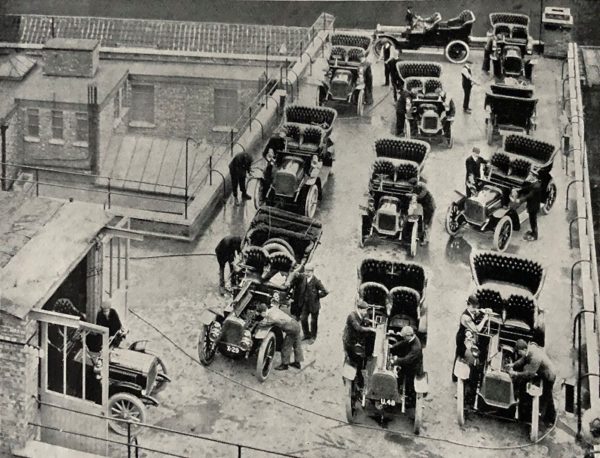
Argyll cars have featured more than once in this website but this picture of twelve new ones together, being washed on the roof of Argyll’s London showrooms, could not be resisted.
Argyll were the most ambitious of the “three As” of Scottish car manufacturers (Argyll, Albion and Arrol-Johnston). Their history started when Alex Govan was a foreman with the Eadie Manufacturing Company, a bicycle manufacturer in Redditch, and some light cars came into the shop in the late 1890s. Working on these gave him a fascination for cars that led him in 1899 to return to his native Glasgow and to found the Hozier Engineering Company (named after its location in Hozier Street) to sell, service and then assemble French cars such as De Dions, Renaults and Darracqs.
The first car of his own Argyll marque was built in 1900 – a 2¾-hp voiturette with a De Dion engine and a tubular steel chassis possibly influenced by Govan’s experience with bicycle manufacture.
Competition success followed, from a reliability trial with no penalties in 1901 to eighth place in the 1905 Tourist Trophy. Govan not only drove personally in as many events as he could, but also used a multitude of press releases to publicise the quality and reliability of the cars, proven in trials and races.
The range expanded to models of 8, 10, 12 and 16 hp, and by 1904 the Hozier Street factory was producing between 20 and 25 cars per week. Demand still exceeded supply; in 1905 Govan therefore liquidated his company, founded a new firm, Argyll Motors Ltd., and started to build a magnificent new factory in Alexandria on the banks of Loch Lomond. It was opened in June 1906 by Lord Montagu. Sadly, it was too magnificent. Designed for 2,500 cars per year, it never achieved half of that. Only true mass production could have justified the capital expenditure and crippling running costs – but engines were hand-built and bench-tested, bodies were finished with over 30 coats of paint and varnish, and every car received a 100-mile road test, so such volumes could never be achieved.
However, 1906 was a positive year. Over 1,000 units left the factory, including cars, cabs and lorries. Our Snapshot was published in June of that year to accompany publicity claiming that 40 to 60 new Argylls were in stock at the London premises, ready for immediate delivery. Prices for a car with a standard side entrance started at £380 for the 10-12 hp and reached £750 for the 26-30 hp, but in a small sign of unrealistic levels of service, the advertisement stated that “Every new car sold from this Depôt is inspected free of charge every two months, and a report handed to the owner of the car.”
Decline started in June 1907 with Govan’s death from a stroke at the age of 38. The company went into liquidation in 1908 and 1,500 workers were laid off. The firm did start again in 1910 as Argyll Ltd., but that is a story for another day.
Picture courtesy of the Richard Roberts Archive







Leave a Comment